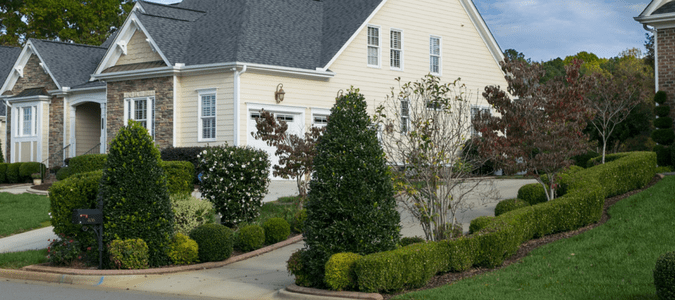
The importance of pruning has been well-documented. Pruning or trimming has many benefits for your landscape, including maintaining plant health, restricting growth (and overgrowth), “training” plants and improving the quality of a plant’s flowers, fruit, foliage or stems.
In our complete guide to pruning, you’ll learn:
- What is pruning?
- How to prune trees
- How to prune shrubs
- How to prune fruit plants and flowers, including roses
- What equipment you need and
- When to prune
What is Pruning?
Pruning is the process of cutting away dead or overgrown branches or stems to promote healthy plant growth. Most plants, including trees, shrubs and garden plants like roses benefit from different methods of pruning and maintenance. Pruning at the wrong time of the year does not necessarily kill your plants, but regular improper pruning may cause damaged or weakened plants.
To help you take the guesswork out of pruning, we’ll go over the common tree and plant types found in the southern United States and explain when and how to prune them.
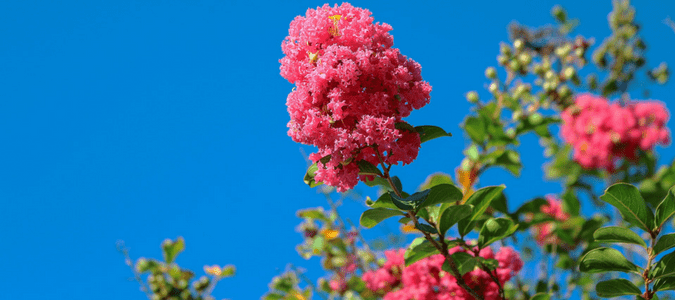
How to Prune Trees
Leaves are important to trees because they help convert sunlight into energy. For that reason, when pruning you want to make sure you don’t remove more than 30% of a tree’s live foliage at one time. There are a few different types of pruning, each which you can do to achieve slightly different results.
Crown lifting
If you want to provide clearance over streets and paths, you may want to perform crown lifting, which is removing the lower branches in the crown. A major benefit is that crown lifting allows more light to pass beneath the crown. This approach is unlikely to alter the tree or harm its top or crown. Lifting means that you are not pruning the more visible higher parts of the crown. When pruning, avoid leaving a clear stem (without branches and leaves) that is more than one-third of the tree’s total height, since branches have a significant role to play in controlling the sway of a tree in high winds.
Crown thinning
As you might guess, crown thinning means removing select branches throughout the crown without significantly changing the shape of the tree’s crown. Crown thinning increases both air circulation and light penetration in the crown. The focus of thinning should be removing the branches that are small in diameter; however, removing too many branches from the crown’s center can result in a tree with a poor structure and little ability to prune it in future seasons. Be careful to avoid long, thin branches and minimal foliage in the lower parts. A tree with these characteristics may be more prone to swaying and may be more vulnerable when it is very windy.
Crown reduction
If you have a tree that has outgrown its space, you might consider crown reduction. Crown reduction shrinks the overall size of the crown by shortening its branches to boost growth. When possible, aim to maintain a flowing branch line matching the natural shape of the tree. Since it often results in large wounds at the branch ends and decay, crown reduction is only done when necessary due to space issues. We rarely recommend crown reduction for trees which take the shape of a pyramid, such as conifers and birches.
Pollarding
Pollarding is a maintenance routine that is started when a tree is young and then repeated at frequent intervals throughout the tree’s life. This technique is traditionally used on willows. Typically small-diameter tree branches are pruned back to the secondary branches off the main stem. Regrowth since the last pollard is then removed back to the tree’s “knuckles.” You may find other gardening sources incorrectly refer to pollarding as the removal of all branches of a mature tree. This practice leaves large wounds and a tree with no foliage with which to produce food. Since this method causes considerable stress to the tree, we recommend against this technique.
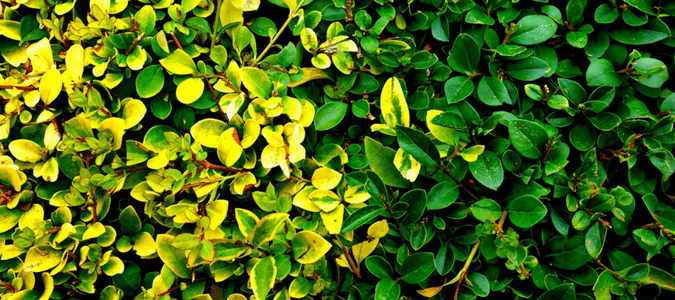
How to Prune Shrubs
For most deciduous shrubs, there are three types of pruning: thinning out, gradual renewal and rejuvenation pruning.
Thinning
If you want to create a more open plant, you may consider thinning out, which is when a branch or twig is cut off at its point of origin from either the parent stem or ground level. Thinning provides room for growth of side branches and will not stimulate excessive new growth in most shrubs. Thinning out also allows plants to be maintained at a specific height and width for many years. We recommend thinning out the oldest and tallest stems first using hand pruning shears.
Gradual Renewal
With gradual renewal pruning, some of the tallest and oldest branches are removed at ground level (or slightly above) on an annual basis. Some thinning may be necessary to shorten long branches or maintain a symmetrical shape.
Rejuvenation
To rejuvenate an old, overgrown shrub, we recommend removing approximately one-third of the oldest, tallest branches at ground level (or slightly above) before new growth starts.
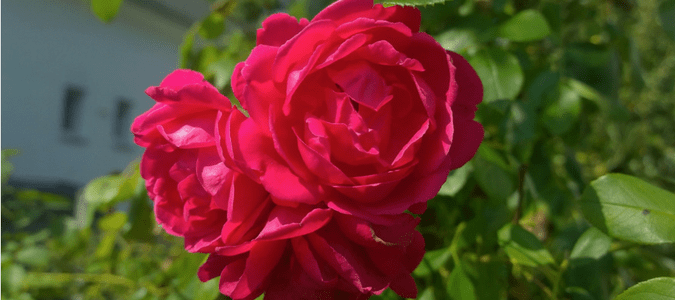
How to Prune Fruit Plants and Flowers, Including Roses
Now that we have covered all the different ways to prune trees, you may be wondering what to do to promote healthy growth of flowering and fruit-bearing plants. Read on to learn more about year-round care for these types of plants.
Flowering Plants
If a shrub is grown for its flowers, carefully choose when you prune it to minimize disrupting its blooming. Spring flowering shrubs typically bloom on last season’s growth and should be pruned shortly after they bloom. Spring blooming trees and shrubs may start to develop new buds as soon as the old buds have fallen. These will need to be pruned shortly after flowering, or you may risk pruning off the new buds when trying to discard the old growth.
Fruiting Plants
Fruit-bearing plants are best pruned while they are dormant, in late winter through early spring. The primary goal in pruning is to remove old, gray-colored, slow-growing shoots, which are non-fruitful. This objective is particularly true for peach trees. Removing 40 percent of the peach tree annually stimulates new growth each spring. Pruning helps to lower the fruiting zone to a height that makes hand harvesting from the ground possible. Also, it opens the center of the tree to increase air circulation, reducing disease pressure while still allowing sunlight into the tree to accelerate fruit color. Finally, pruning is needed to remove diseased or dead shoots, rootstock suckers and any water shoots.
Roses
Roses need pruning to keep them attractive and productive in your garden. Typically this is done during the mid-winter while rose bushes are mostly dormant and have much less foliage. Some fundamental objectives of pruning roses that most rose experts or “rosarians” agree upon include the removal of weak, dead and diseased canes; removal of distorted (crooked or twisted) canes and crossing (or conflicting) canes. Another important objective of pruning a rose is to open up the center of the plant to allow air and sunlight to penetrate. The rose bush’s shape and growth may depend upon the type or variety of the plant. Pruning also maintains a good balance between older and younger growth appropriate to the type, health and age of the plant and its usage (e.g. general landscape, specimen, cut flower, etc.).
When thinking about how to prune roses, it’s important to note that well placed, clean-pruning cuts significantly reduce the incidence of cane canker disease, the leading cause of deadwood in rose bushes. Rose pruning should be done with hand pruners. We suggest using a bypass style pruner rather than an anvil-style pruner.
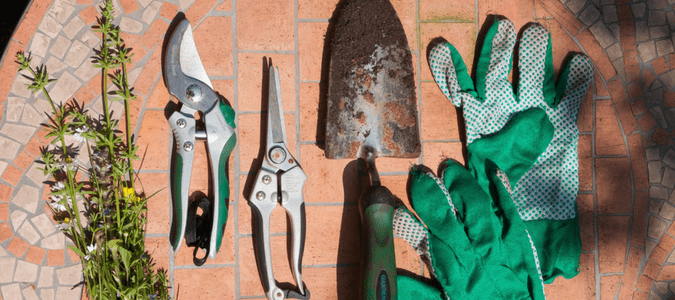
What Equipment You Need
Learning which plants to prune and how to prune them are important, but using the correct tools is also important. Select tools that will do the job, keep a sharp edge and are relatively easy to sharpen and handle.
Garden centers and home improvement stores carry many kinds of hand pruning shears. Most of them are designed for cutting stems of up to 1/2 inch in diameter. Do not attempt to use hand pruning shears to cut larger branches, as this could ruin your shears or damage your plant.
Types of Shears
Two common styles of hand shears are those with a scissor action and those with an anvil cut. With scissor-action shears, a thin, sharp blade slides closely past a thicker but also sharp blade. These may cost more but make cleaner, closer cuts. Anvil cut shears have a sharpened blade that cuts against a broad, flat blade.
Loppers, Pruners and Saws
For pruning trees, there are several tool types. A lopper is often used for pruning medium to large branches with diameters of 2-1/2″ or less, typically on fruit trees, vines and nut trees. A pole pruner takes dead wood out of trees of all types with branches of 1-1/4″ or less in diameter. If you want to prune medium to large low-hanging branches with diameters of 1-1/2″ or more, we recommend a pruning saw. A tree pruner is designed for any tree branches of 1-1/4″ or less in diameter that may eliminate the need for a ladder.
Equipment Care
Good equipment which is properly cared for does a better job and lasts longer. Be sure to store your tools in a dry room, keep it sharp and maintain its good operating condition by using it on a yearly basis.
When pruning diseased plants, disinfect all shears and saw blades after each cut to prevent spreading disease to healthy plants. Clean and disinfect equipment between each cut when pruning diseased plants with alcohol or bleach by mixing one part bleach to nine parts water. Then oil the pruning equipment well to avoid any rust formation.
When to Prune
The best time to prune trees and shrubs in the climate prevalent in the southern United States is January through early March when trees and shrubs are considered dormant. These months are also the best time to move established plants to new locations.
Trust Your Pruning to the Experts at ABC
Knowing exactly when and how to prune the plants in your yard can be a challenge, especially if you don’t have the right equipment. If you prefer to leave pruning to an expert, especially for your large trees like valuable oaks and crepe myrtles, look no further than ABC Home & Commercial Services. Our International Society of Arboriculture (ISA)-certified arborists will help maintain good tree health, provide proper pruning and trimming, feed trees with deep root fertilizers, perform storm damage care and assist with overgrown branches or root systems. With the help of our certified experts, your trees, shrubs, plants and home are in good hands!
